
Top Eight Tibetan Buddhist Demons
One of the most interesting aspects of the Tibetan culture is, undoubtedly, its mystical religion. When I say religion, I’m referring to the dominant one found here - Tibetan Buddhism. In case you’re unfamiliar with it, it’s a branch of Buddhism that has blossomed out of the marriage between the religious faiths of Mahayana and Bon. For the purpose of the topic we’ll be exploring, you needn’t get caught up in the intricacies of the faith. All you really need to be aware of, for now, is that because of its foundation stemming in large part from the Bon faith, Tibetan Buddhism embraces Shamanic practices.
 Tibetan Buddhism shrine
Tibetan Buddhism shrine
So, maybe you’re interested in what Shamanism really means, and how this pertains to the enchanting world of demons we’ll be discussing here. Well, in reality, Shamanism has everything to do with demons, because a shaman is, in fact, an individual who has the capability of interacting with spirits.
 Tibetan Shamans
Tibetan Shamans
Until now, you’ve likely only been exposed to the bastardized version of traditional shamans; you know, in western television programs, wherein the “kook next door” is avoided and ostracized because of his bizarre claim to be conversing with the deceased. So, here’s where we give you the opportunity to become a little more cultured and learn about the real shamanistic practices—those ancient rituals that play a significant role in Tibetan heritage and even present-day culture. Ready? Read on.
The backstory: shamans & the deities
Ever since the term first emerged in the mid sixteenth century, shamans have been distinguished for their role as mediators between the earthly world we all inhabit and the spiritual world, where allegedly both good and evil deities are present.
 Shaman Festival
Shaman Festival
In society, shamans have traditionally played the role of the healer—sometimes they are even referred to as community heroes. It is believed that, in connecting with the spiritual world, they can help us have a greater relationship with this world of the deities, which promotes a peaceful living environment; plus, this communication is believed to promote a closer relationship with our own spiritual self, otherwise known as our soul. This latter part has been deemed a vital focus for individuals suffering from psychological trauma.
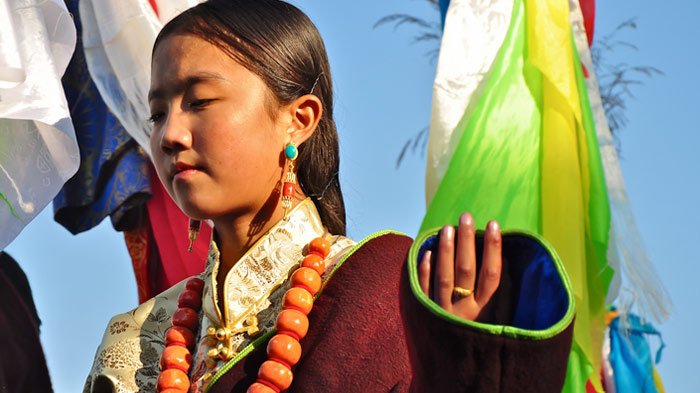 Girl dressed up for Shaman Festival
Girl dressed up for Shaman Festival
In essence, shamanistic practices promote consciousness of the spiritual world and our spiritual selves, and this alertness allows us to identify more readily where certain imbalances—that are leading to our unhappiness—may be stemming from, so that, ultimately, we may restore their balance and achieve bliss. Curious about what some of these practices or rituals are? The most prevalent are exorcisms—to rid the body of demons that may have invaded—angel book readings, Medicine or Sacred Path card readings, and then those forms of communication that allow us to interact with the spirits we are seeking; these forms of communication range from meditations, to prayers, to offerings.
So, now onto perhaps the most interesting part of all of this: the spirits. Let’s “meet” them, shall we?
Yama
We’ll start by introducing you to this god of the dead, Yama. This wrathful deity has the authority to determine whether one has been a good person in his life, or whether he has not—meaning if you want to achieve Nirvana, you better be in his good books when your body perishes and your soul arrives at his palace. He is famous for trying to viciously kick his own mother, and, as a result, baring the curse of a on horseback, often trampling groups of people.
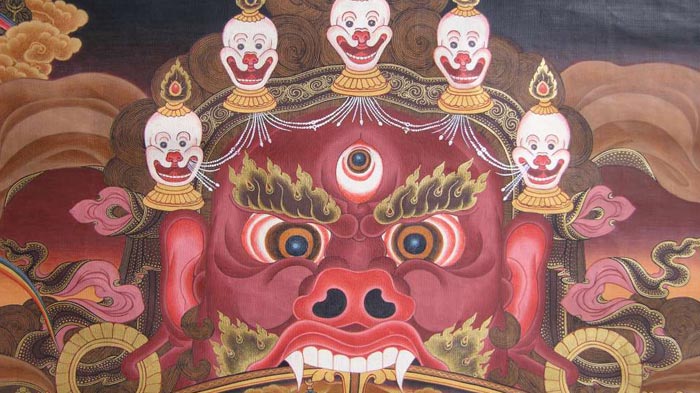 Yama thangka
Yama thangka
Mahakala, The Great Black One
This deity is often referred to as the protector of education, or dharma, for his main concern is preventing corruption when it comes to the ancient teachings of Buddhism. There are a variety of Mahakalas noted in ancient scripture. They each serve their own purpose for us earthly beings, some helping to guide us on our path to enlightenment, others helping us to become more wealthy in this physical world. The black one we discuss here is of the first variety, and he can be distinguished by what he holds in his hands: a skull and an axe.
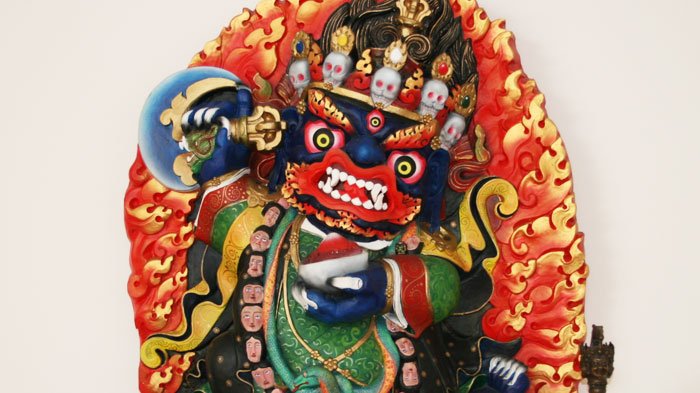 Mahakala, the Great Black One
Mahakala, the Great Black One
Yamantaka, The Conqueror of Death
This “demon” is actually looked on by Tibetan Buddhists—specifically those of the Gelug and Sakya sects—as less fearsome, and more a figure in which we ought to give thanks. Why? He’s believed to be one of our protectors, saving us especially from Yama. Look out for him in traditional artwork; you’ll be able to distinguish him by his blue-coloured buffalo head, and his seething facial expression, which is meant to be directed at Yama, the god he is on a mission to destroy.
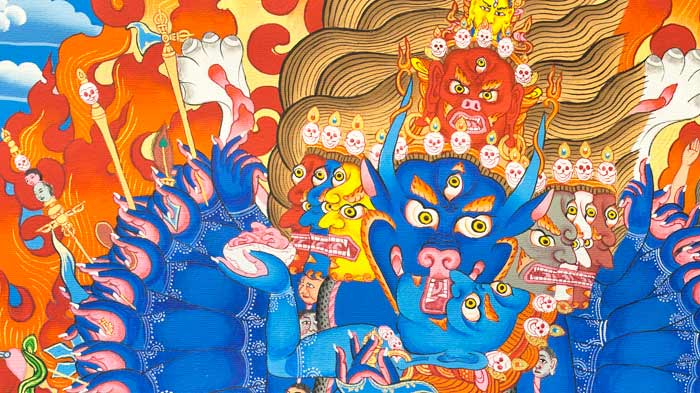 Yamantaka thangka
Yamantaka thangka
Vaisravana/Kubera, The God of Wealth
According to ancient text, it took one thousand years of good work for Vaisravana to be deemed a god, but once he was, he was extremely highly revered. The people looked to him as their trusted guardian. Perhaps because he existed for so long as a being of the physical world—prior to being deemed a deity, once he was a god, he was presented as one through the material goods. This is why he is referred to as the god of the wealth. You’ll recognize him in pieces of art by his round body and the inordinate amount of jewels that cover him.
 Vaisravana thangka
Vaisravana thangka
Hayagriva, The Horse-Necked One
Manifesting from the Buddha of compassion, Hayagriva, represents the passion that lies at the heart of anger. In other words, he is the embodiment of what has been referred to as “fierce energy.” Tibetan Buddhists look to this spirit when they encounter struggles in their lives. With his help, they can channel their upset into overcoming any difficulty that presents itself in their path. As its nickname suggests, he may be recognized easily by his second head, which is that of a horse. The purpose of the horse? It symbolizes enlightenment, for the horse’s neigh has long been attributed with clarity of the mind, the ability to see past false pretences that can entrap us in superfluous earthly “problems”.
 Hayagriva thangka
Hayagriva thangka
Palden Lhamo
The most revered of all the protectors is also the only woman of them all, Palden Lhamo. She is credited with providing the very best care for the king’s shrine, preventing any damage occurring to it for over 1500 years—ever since vowing to guard it in the mid 600s. If you happen to visit the Tibet’s sacred lake, Lhamo Latso, know that she is one of its protectors and it is because of her affiliation with it that it has become so hallowed. If you’re looking for her in artwork, she’s the figure you’ll see atop a mule, with long, flowing red hair and a blue body.
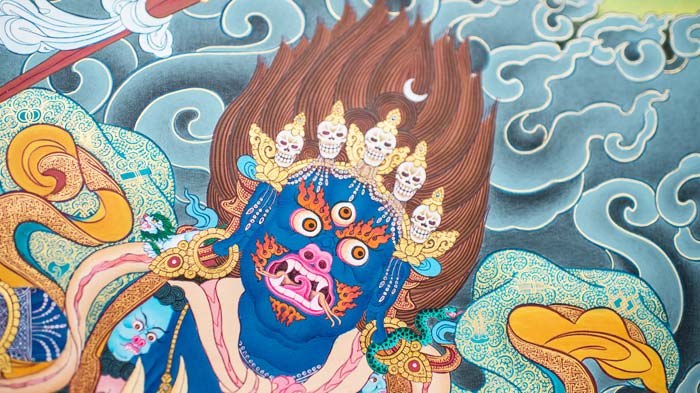 Palden Lhamo thangka
Palden Lhamo thangka
Ekajati
Do you find yourself attracted to power and darkness? Ekajati will probably be the most interesting to you. She’s known to be the most potent, dark female deity. She’s easily recognized for she has only one eye, one tooth, one breast, her hair is always wrapped up in a bun, and she is most often found stomping on what is supposed to be the “corpse of the ego.” The point of all these solo attributes? Her only having one of all these major body parts is supposed to signify that she is at one with the universe and with its creator.
 Ekajati thangka
Ekajati thangka
Begtse, The Goddess of War
Finally, we come to the goddess of war, or Beg-tse. She is most appreciated by the Sakya and Gelug sects of Tibetan Buddhism, where they pray to her through meditative practices, like tantra. When it comes to her portrayal in art, you’re most likely to see her in the form of coral masks, which represent her affiliation with combat.
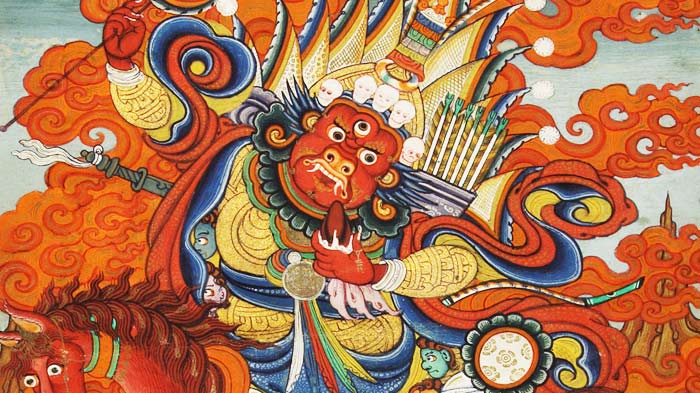 Begtse thangka
Begtse thangka
Tibet, continuously inspiring self-growth
We hope you’ve kept your mind open as you went through and absorbed all this information. It’s fascinating, isn’t it? There’s a whole other spiritual world out there that’s just waiting to be explored, by you—and especially when you visit Tibet. Our advice? Ask some elderly locals to tell you about the spirits and then sit back and revel in this mystical world you’re being exposed to. If this experience doesn’t change your life, it’ll be, at the very least, incredibly riveting in the time being and give you great stories to share when you return home.
Which deity most peaked your interest?

Kham Sang is responsible and honest with more than six years of guide experience in Tibet.She has strong interpersonal skills and can communicate effectively with tourists.


.jpg)




0 Comment ON "Top Eight Tibetan Buddhist Demons"